1. Introduction
- Introduction
 Asus is well known for introducing innovative products into the market. Recently, Asus announced a motherboard with x4 PCI-E slots, the P5W64WS Pro series. The WS stands for WorkStation board. Typical demands for this category of board are that it should be very stable and equipped with enough ports and connections to cover just about all business use. Memory compatibility and stability is an absolute must for a workstation board. Of course, overclocking should be possible even though this category of board isn't designed with gamers in mind.
Asus is well known for introducing innovative products into the market. Recently, Asus announced a motherboard with x4 PCI-E slots, the P5W64WS Pro series. The WS stands for WorkStation board. Typical demands for this category of board are that it should be very stable and equipped with enough ports and connections to cover just about all business use. Memory compatibility and stability is an absolute must for a workstation board. Of course, overclocking should be possible even though this category of board isn't designed with gamers in mind.
- Asus P5W64 WS Pro
The Asus P5W64WS Pro is based on Intel's 975 chipset, which supports Intel®Core™2Extreme, Core™2Duo, Pentium®4EE, Pentium®D, Pentium®4, CeleronD processors for Socket (LGA775). It features 1066/800/533MHz(FSB), dual-channel un-buffered DDR2 667/533/400 x 4DIMMs with a maximum of 4GB.
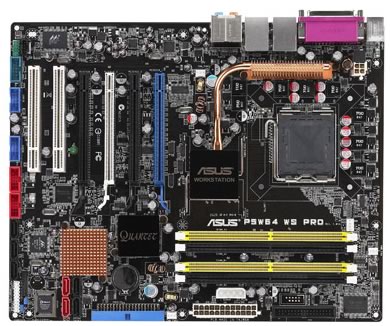
- Main features
The Wall Street Quartet is the ideal foundation for a powerful workstation. It delivers awesome power, dependable performance and unparallel I/O scalability for the most demanding tasks and future upgrades. With the incorporation of ASUS Intelligence (AI) Technology, the Main Station Series intelligently reduces operation noise and dissipates heat through advanced and environmentally friendly methods to accommodate user needs. Don't change yourself for a computer. Instead, Let the Main Station Series improve the quality of your work and your life. The main features of P5W64WS Pro are:
- Intel® Quad-core CPU Ready
- Intel Core™2 Extreme / Core™2 Duo Ready
- Quad-core CPU Ready
- DDR2 800/667/533
- FSB 1066/800/533
- Quad PCI-E x 16 slots
 LGA775 Intel® Quad-core Processor Ready LGA775 Intel® Quad-core Processor Ready
This motherboard supports the latest Intel® Quad-core processors in LGA775 package.
It's excellent for multi-tasking, multi-media and enthusiastic gamers with 1066/800 MHz FSB.
Intel® Quad-core is one of the most powerful CPU in the world.
 LGA775 Intel® Core™2 Processor Ready LGA775 Intel® Core™2 Processor Ready
This motherboard supports the latest Intel® Core™2 processors in LGA775 package. With new Intel® Core™ microarchitecture technology and 1066 / 800 MHz FSB, Intel® Core™2 processor is one of the most powerful and energy efficient CPU in the world.
 Intel® 65nm Dual-Core CPU support Intel® 65nm Dual-Core CPU support
This motherboard supports Intel Pentium D/Pentium 4/Celeron dual-core processors built on the 65-nanometer (nm) process technology with copper interconnect.
|

Intel® MPT (Intel® Memory Pipeline Technology)
The Intel® Memory Pipeline Technology (Intel MPT) delivers additional system-level performance by optimizing memory access between CPU and system memory, and allows increased performance at standard operating specifications. |
|
 Intel 975X chipset Intel 975X chipset
The Intel 975X is the latest chipset designed to support Dual PCI Express graphics, along with the maximum 8GB dual-channel DDR2 667/533 architecture, 1066/800 FSB (front-side-bus), and Dual-core CPU. Easily build a workstation or create a multimedia environment with its exceptionally high bandwidth. Together with the Serial ATA ports enabled through the SATA 3Gb/s RAID controller integrated in the ICH7R Southbridge, the Intel 975X satisfies multi-task processing and data security. |
Advanced Thermal Design
ASUS has devoted special efforts to address the thermal issues across the motherboard, and most notably the areas that reside the CPU, power, Northbridge and Southbridge.

Stack Cool 2
Stack Cool 2 is a fan-less and zero-noise cooling solution offered exclusively by ASUS. It effectively transfers heat generated by the critical components to the other side of the specially designed PCB (printed circuit board) for effective heat dissipation.
8 Phase Power Design 
ASUS 8-Phase Power Design keeps CPU and power module away from suffering risk of high power stress, which makes CPU lifetime much longer and system more stable. Furthermore, It provides high efficiency operation to generate less heat than conventional power solutions and consequently achieve cool system environment. With this strong power pump, this motherboard is made for overclocking.
 Fanless Design: Heat-pipe Thermal solution Fanless Design: Heat-pipe Thermal solution
Cooling fans, though a popular thermal solution, also come with noise and malfunction likelihood. ASUS Motherboard's fanless concept is specifically created to provide a cool environment without all the baggage.
The heat pipe, heat sinks and strategic board layout were tailor made to dissipate heat in the most efficient manner.
|

AI Clock Skew
AI Clock Skew automatically skews the memory clock signal timing, thus improving memory overclocking capability by 10 to 15%, depending on the memory features when users overclock memory frequency. Users can easily enjoy better memory overclocking without strenuously fine-tuning the clock signal timing. For professional users, they can still adjust each memory channel's clock signal separately to reach the highest memory frequency.
|
 ASUS O.C. Profile ASUS O.C. Profile
The motherboard features the ASUS O.C. Profile that allows users to conveniently store or load multiple BIOS settings. The BIOS settings can be stored in the CMOS or a separate file, giving users freedom to share and distribute their favorite overclocking settings.
|
 Precision Tweaker Precision Tweaker
It offers ways to raise system performance inch-by-inch and step-by-step to achieve maximum performance! This is about getting the most out of your machine and taking pride in your customized computer.
|
|
AI NOS™ 
Applications such as 3D games and video editing demand a huge chunk of system resource. Inject "nitrous oxide" into your CPU! The patented AI NOS™ (Non-delay Overclocking System) technology intelligently detects system load and automatically boosts performance for the most demanding tasks. Unlike other dynamic overclocking techniques, AI NOS™ reacts much faster to satisfy your unending need for speeds.
|
PEG Link 
This latest technology, PEG (PCI Express Graphics) Link Mode, is a unique feature that enables users to boost graphics card performance for superior video quality. PEG Link allows users to raise GPU and VGA memory throughput via the motherboard BIOS the same way system bus and memory bus are tweaked. PEG Link Mode enables powerful video performance on DX8 and DX9 applications. ASUS engineers carefully fine-tuned the parameters for every single PCI-Express card to provide system stability during high-speed graphics operation.
|
 AI Gear AI Gear
To balance both system performance and quietness, AI Gear allows users to choose from profiles to adjust CPU frequency and vCore voltage, minimizing system noise and power consumption. Users can real-time change the mode under operating system to suit their needs.
|
 AI Nap AI Nap
With AI Nap, users can instantly snooze your PC without terminating the tasks. System will continue operating at minimum power and noise when user is temporarily away. It keeps downloading files or running applications in quietest state while you're sleeping. Simply click keyboard or mouse, you can swiftly wake up the system in few seconds.
|
ASUS Q-Connector
The ASUS Q-Connector allows you to connect or disconnect chassis front panel cables in one easy step with one complete module. This unique adapter eliminates the trouble of plugging in one cable at a time, making connection quick and accurate.
|
ASUS CrashFree BIOS 3
The ASUS CrashFree BIOS 3 allows users to restore corrupted BIOS data from a USB flash disk containing the BIOS file. This utility saves users the cost and hassle of buying a replacement BIOS chip.
|
ASUS EZ Flash 2
EZ Flash 2 is a user-friendly BIOS update utility. Simply launch this tool and update BIOS from a USB flash disk before entering the OS. You can update your BIOS only in a few clicks without preparing an additional floppy diskette or using an OS-based flash utility.
|
ASUS MyLogo2
The ASUS MyLogo2 is the new feature present in the motherboard that allows you to personalize and add style to your system with customizable and animated boot logos.
|
PCI Express Architecture 
PCI Express is the latest I/O interconnect technology that will replace the existing PCI. With a bus bandwidth 4 times higher than that of AGP 8X interface, PCI Express x16 bus performs much better than AGP 8X in applications such as 3D gaming. PCI Express x1 also outperforms PCI interface with its exceptional high bandwidth up to 500MB/s. The high speed PCI Express interface creates new usages on desktop PCs e.g., Gigabit LAN, 1394b, and high-speed RAID systems. |
Dual Gigabit LAN
The integrated dual Gigabit LAN design allows a PC to serve as a network gateway for managing traffic between two separate networks. This capability ensures rapid transfer of data from WAN to LAN without any added arbitration or latency.
|
High Definition Audio
Enjoy high-end sound system on your PC! The onboard 8-channel HD audio (High Definition Audio, previously codenamed Azalia) CODEC enables high-quality 192KHz/24-bit audio output, jack-sensing feature, retasking functions and multi-streaming technology that simultaneously sends different audio streams to different destinations. You can now talk to your partners on the headphone while playing a multi-channel network games. All of these are done on one computer.
|
SATA on the Go
The P5W64 WS Professional supports the next-generation hard drives based on the Serial ATA (SATA) 3Gb/s storage specification, delivering enhanced scalability and doubling the bus bandwidth for high-speed data retrieval and saves. The external SATA port located at the back I/O provides smart setup and hot-plug functions. Easily backup photos, videos and other entertainment contents on external devices.
|
IEEE 1394a interface
IEEE 1394a interface provides high speed digital interface for audio/video appliances such as digital television, digital video camcorders, storage peripherals & other PC portable devices. |
- Full specifications
CPU |
Intel® Quad-core CPU Ready
LGA775 socket for Intel® Pentium Processor Extreme Edition / Pentium D / Pentium 4 / Celeron CPU
Support Intel 65nm, Core™2 Extreme / Core™2 Duo
Support Intel next generation Mulit-Core CPU
Compatible with Intel 06B, 05B/ 05A and 04B/04A processors
Intel EM64T and Hyper-Threading Technology ready
|
Chipset |
North Bridge: Intel 975X (support ATi CrossFire dual Gfx technology)
South Bridge: Intel ICH7R
PCIe Switch: IDT 89HA0324
|
Front Side Bus |
|
Memory |
4 x DIMM, max. 8GB, DDR2 667/533, ECC and non-ECC un-buffered memory
Dual channel architecture
Native DDR2 800 Support
|
Expansion Slots |
4 x PCI-E x 16 slots (at x8, x8, x4, x8 or at x16, x0, x4, x0)
2 x PCI 2.2 slots
|
| Crossfire |
Supports ATI Crossfire graphics cards |
Storage |
Intel ICH7R controller supports:
- 4 x SATA 3.0Gb/s (RAID 0,1,10,5)
- 1 x UltraDMA 133/100
Marvell 88SE6145 supports:
- 3 x SATA 3.0Gb/s (RAID 0,1,10)
- 1 x eSATA 3.0Gb/s
|
Audio |
ADI 1988B 8-channel High Definition Audio CODEC
Support Jack-Sensing, Enumeration, Multi-streaming and Jack-Retasking
Coaxial, Optical S/PDIF out on back I/O port
|
LAN |
Marvell 88E8052 + 88E8001PCI-E Dual Gb LAN controller
Support Teaming function
|
USB |
|
Overclocking Features |
ASUS AI NOS™
AI Overclocking
AI Clock Skew
ASUS PEG Link
Hyper Path 3
ASUS BIOS Profile
ASUS C.P.R.
ASUS AI Booster
Adjustable FSB/DDR2 ratio. Fixed PCI/PCIe frequencies.
Precision Tweaker:
- vDIMM: 12 step DRAM voltage control
- vCore: Adjustable CPU voltage at 0.0125V increment
- SFS (Stepless Frequency Selection): allowing FSB tuning from 100 MHz up to 550 MHz at 1MHz increment
- PCIe x16 Frequency: allowing PCIe x16 frequency from 90MHz up to 150MHz at 1MHz increment
|
Advanced Thermal Design |
8-Phase Power Design
Stack Cool 2
Q-Fan 2
ASUS Heat-pipe thermal solution
|
ASUS AI Lifestyle Features |
Multi-language BIOS
SATA on the Go
AI Nap
AI Gear
My Logo 2
|
Other ASUS Special Features |
ASUS AI NET2
CrashFree BIOS 3
EZ Flash 2
Q-Connector
ASUS AI Quiet
TPM (Trusted Platform Module) 1.2 (optional)
|
Back Panel I/O Ports |
Parallel
PS/2 Keyboard
PS/2 Mouse
RJ45
S/PDIF Out (Coaxial + Optical)
4 x USB
eSATA
Audio I/O
|
Internal I/O Connectors |
4 x USB
8-pin ATX+12V power
24-pin ATX Power connector
Chassis intrusion
CPU fan with PWM control
Chassis fan1 with Q-fan control
Chassis fan2 with Q-fan control
PWR fan
IDE connector
Floppy disk drive connector
Serial ATA connectors
CD audio in
IEEE 1394a port
Front panel audio connector
|
BIOS |
8Mb flash ROM, AMI BIOS, Green, PnP, DMI, Wfm2.0, ACPI v2.0a, SMBIOS v 2.3, EZ flash, CrashFree BIOS2
|
Manageability |
WOL by PME, WOR by PME, PXE, AI NET, Chassis Intrusion
|
Support CD |
Drivers
BIOS flash utility under DOS
AI Booster
ASUS PC Probe II
RAID utility
Anti virus software
Adobe Acrobat Reader ver 7.0
Microsoft Direct X ver 9.0C
|
Accessories |
User's manual
UltraDMA cable
FDD cable
2-port USB module
2-port 1394a module
I/O shield
SATA cable
SATA power cable
Media Launcher
|
Form Factor |
ATX Form Factor, 12"x 9.6"(30.5cm x 24.5cm)
|
2. The Package
- The Package
The Asus P5W64WS Pro package is big and costs around US$290~324, making it an expensive solution. Of course, its unique features make it an appealing choice for many users.

The package includes all required information and details of its special features. Below is a list of what's included in the retail package:
- 1x UltraDMA 133/100/66 cable
- 1x FDD cable
- 4x SATA cables
- 4x SATA power cables
- 1x I/O Shield
- 1x printed user's manual
- 1x USB2.0 port module
- 1x 3in1 Q-connector
- 1x IEEE1394a port module
- 1x Serial port module
- 1x CD-ROM with InterVideo® Media Launcher (WinDVD Creator 2, InterVideo PhotoAlbum, DiscMaster 2.5 Platinum, DVD Copy 2.5 Platinum)
A flyer with installation and motherboard information
- 1x CD-ROM with drivers

The board, as with most motherboards is densely packed with components but the layout is clean and all parts can be identified easily:

Below, the CPU region.

Note the passive cooling solution for the northbridge. As Asus comments "...The Heat Pipe design effectively directs the heat generated by the chipsets to the heatsink near the back IO ports, where it can be carried away by existing airflow from CPU fan or bundled optional fan...". Any nearby capacitors are low profile so there shouldn't be any problem installing any of the larger, 3rd party CPU cooling solutions. The Asus P5W64 WS Pro has four memory banks. There is also an extra power input for higher system stability in case you install multiple VGA cards:

A passive heatsink is also used on the Southbridge as shown below.

The Asus P5W64 WS Pro supports ATI Crossfire, although the official specs don't mention it. There are 4x PCI-E x16 slots. If you install four VGA cards, each slot works at x8 (x8, x8, x4, x8). If you install two VGA, cards at x16 ( x16, x0, x4, x0). The downside is that the slots are placed very close to each other so you may have trouble fitting in any of the larger sized cards which tend to overlap onto the next PCI-E slot. Between the last PCI-E and PCI slots, there is a green led that shows the operating status of the board:

There are several extra connections for USB, Front Panel Audio, COM2 and Firewire. Asus has activated all port available on the motherboard and included all cables in the retail package. The back I/O panel has the usual connections:
- 1x Parallel port
- 1x PS/2 Keyboard
- 1x PS/2 Mouse
- 2 x RJ45 port (1GBit LAN)
- 1x S/PDIF Out (Coaxial + Optical)
- 4x USB
- 1x eSATA
- 8-Channel Audio I/O

3. Bios
- BIOS
The BIOS is the typical AMI we saw in ASUS motherboards. The first tab, "Main", includes the system time and date, and storage devices:

The second is the "advanced" tab and includes most of the board configuration options:

Below we can see the settings under JumperFree Configuration. The CPU Frequency which is also the FSB, can be set as high as 550, a rather unrealistic number:

The DRAM Frequency setting offers 8 options, from Auto to DDR2-1067MHz.

Each setting represents a different FSB:RAM ratio:
- DDR2-400 (4:3)
- DDR2-533 (1:1)
- DDR2-667 (4:5)
- DDR2-771 (3:4)
- DDR2-800 (2:3)
- DDR2-889 (3:5)
- DDR2-1067 (1:2)
If you overclock by increasing the FSB, the DRAM Frequency changes on-the-fly accordingly, a useful feature. Memory, CPU, FSB, NB, SB and ICH voltages can be set according to the following table.
| BIOS Setting |
Feature: |
CPU bus frequency |
100 to 550MHz in 1MHz steps |
CPU voltage |
1.2875V to 1.7000V in 0.0125V steps |
DRAM voltage |
1.85V to 2.40V in 0.15V steps |
PCI Express frequency |
90 to 150MHz in 1MHz steps |
i975X MCH voltage |
1.50V to 1.80V in 0.10V steps |
FSB voltage |
1.20V to 1.50V in 0.10V steps |
ICH7R voltage |
1.05V and 1.20V only |







In the Advanced CPU settings, we can set the CPU Ratio status (set modify Ratio Support to Enabled) and enable or disable SpeedStep Technology (set C1 Support to Disabled):

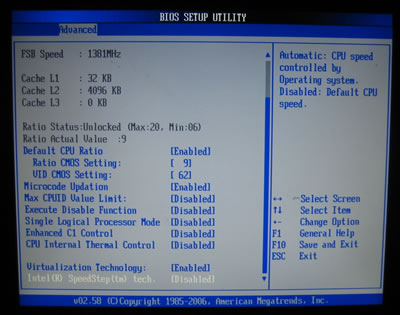
The Northbridge chipset controls the DRAM. By default, we left settings at Auto. Of course, users can take control and adjust the memory timings. There are two settings for higher memory performance (Hyper Path 3 and DRAM Throttling Threshold):

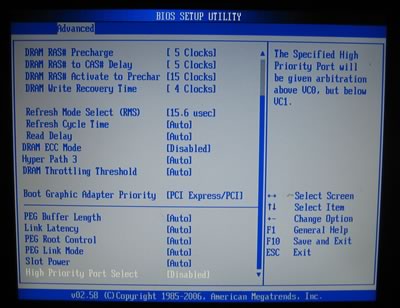
Hardware monitor shows how hot your CPU and motherboard run, fan speeds and voltages:

4. Installation
- Installation
Using Everest Ultimate Edition 2006, we can get fairly detailed rundown on our P5W64WS Pro:

Both the North Bridge and South Bridge chipsets unveiled:


For our review, we had the latest available BIOS (0402 release). What troubled us is that with our default setup (memory modules 2x1GB Crucial PC2-8000), the P5W64 WS Pro couldn't get a stable memory divider at 1:2 (1067MHz). We assume this is a BIOS problem and hopefully will be fixed with a newer revision. Let's now see how our CPU was identified with CPU-Z:

More information on our motherboard:

For comparison, we also post the test results for the following motherboards:
- Asus P5B Deluxe with memory running at 534@5-5-5-15
- Intel DX975XBX2 with memory running at 400@4-4-4-8
- Asus P5W64 WS pro with memory running at 445@5-5-5-15
5. Everest Ultimate Edition 2006 - Sisoft Sandra
- Everest Ultimate Edition 2006
 EVEREST Ultimate Edition is an industry leading system diagnostics and benchmarking solution for enthusiasts PC users, based on the award-winning EVEREST Technology. During system optimizations and tweaking it provides essential system and overclock information, advanced hardware monitoring and diagnostics capabilities to check the effects of the applied settings. CPU, FPU and memory benchmarks are available to measure the actual system performance and compare it to previous states or other systems. Furthermore, complete software, operating system and security information makes EVEREST Ultimate Edition a comprehensive system diagnostics tool that offers a total of 100 pages of information about your PC. The software has built-in, several tests for memory and CPU/FPU.
EVEREST Ultimate Edition is an industry leading system diagnostics and benchmarking solution for enthusiasts PC users, based on the award-winning EVEREST Technology. During system optimizations and tweaking it provides essential system and overclock information, advanced hardware monitoring and diagnostics capabilities to check the effects of the applied settings. CPU, FPU and memory benchmarks are available to measure the actual system performance and compare it to previous states or other systems. Furthermore, complete software, operating system and security information makes EVEREST Ultimate Edition a comprehensive system diagnostics tool that offers a total of 100 pages of information about your PC. The software has built-in, several tests for memory and CPU/FPU.

The motherboard with the best memory performance was the Asus P5B Deluxe. This is because the memory on the PB5 can be set to operate at FSB:RAM ration of 1:2, resulting in higher running speeds than with the other two motherboards. The P5W64 WS Pro had the best memory write performance. We assume when Asus solves the FSB:RAM 1:2 ratio setting, the Asus P5W64WS Pro should be able to offer even better memory performance than the P5B Deluxe.

In the CPU tests, it was a bit of a mixed bag. Depending on the benchmark performed, the Asus P5W64WS Pro was in some cases slower and in other cases faster than the other two motherboards.
 SiSoftware Sandra (the System ANalyser, Diagnostic and Reporting Assistant) is an information & diagnostic utility. It should provide most of the information (including undocumented) you need to know about your hardware, software and other devices whether hardware or software. It works along the lines of other Windows utilities, however it tries to go beyond them and show you more of what's really going on. Giving the user the ability to draw comparisons at both a high and low-level. You can get information about the CPU, chipset, video adapter, ports, printers, sound card, memory, network, Windows internals, AGP, PCI, PCIe, ODBC Connections, USB2, 1394/Firewire, etc. Sisoft Sandra offers a variety of tests for Memory and CPU.
SiSoftware Sandra (the System ANalyser, Diagnostic and Reporting Assistant) is an information & diagnostic utility. It should provide most of the information (including undocumented) you need to know about your hardware, software and other devices whether hardware or software. It works along the lines of other Windows utilities, however it tries to go beyond them and show you more of what's really going on. Giving the user the ability to draw comparisons at both a high and low-level. You can get information about the CPU, chipset, video adapter, ports, printers, sound card, memory, network, Windows internals, AGP, PCI, PCIe, ODBC Connections, USB2, 1394/Firewire, etc. Sisoft Sandra offers a variety of tests for Memory and CPU.
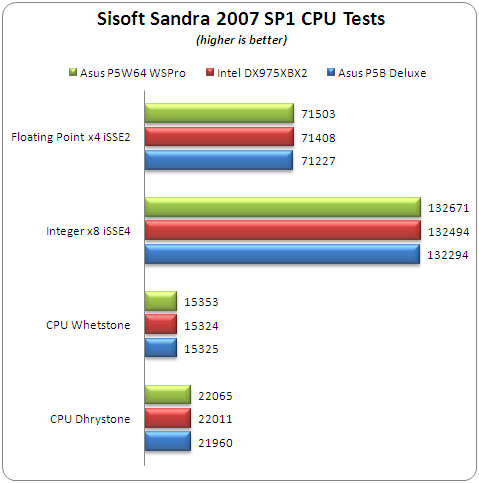
In Sisoft Sandra 2007 SP1 CPU tests, the Asus P5W64WS Pro was the fastest of the three motherboards.
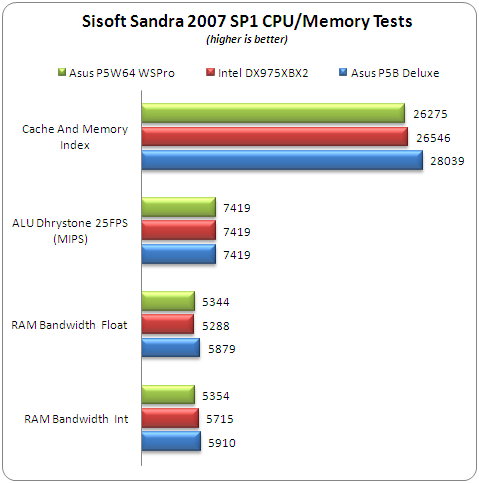
6. PC Mark05 - 3D Mark06
 PCMark®05 is everything you need to reliably and easily measure the performance of your PC and determine its strengths and weaknesses. With PCMark05, you will be able to select the optimal upgrades for your existing PC, or choose the right new PC that fits your specific needs. This easy-to-use product gives you the same tools and knowledge that virtually every professional tester in the industry uses. Below you can see all three available scores, memory, CPU and total.
PCMark®05 is everything you need to reliably and easily measure the performance of your PC and determine its strengths and weaknesses. With PCMark05, you will be able to select the optimal upgrades for your existing PC, or choose the right new PC that fits your specific needs. This easy-to-use product gives you the same tools and knowledge that virtually every professional tester in the industry uses. Below you can see all three available scores, memory, CPU and total.

In the memory and CPU score, the Asus P5W64WS Pro had the better performance, but surprisingly, in the overall score, it registered a much lower score than the other two motherboards.
 3DMark®06 is the worldwide standard in advanced 3D game performance benchmarking. A fundamental tool for every company in the PC industry as well as PC users and gamers, 3DMark06 uses advanced real-time 3D game workloads to measure PC performance using a suite of DirectX 9 3D graphics tests, CPU tests, and 3D feature tests. 3DMark06 tests include all new HDR/SM3.0 graphics tests, SM2.0 graphics tests, AI and physics driven single and multiple cores or processor CPU tests and a collection of comprehensive feature tests to reliably measure next generation gaming performance today.
3DMark®06 is the worldwide standard in advanced 3D game performance benchmarking. A fundamental tool for every company in the PC industry as well as PC users and gamers, 3DMark06 uses advanced real-time 3D game workloads to measure PC performance using a suite of DirectX 9 3D graphics tests, CPU tests, and 3D feature tests. 3DMark06 tests include all new HDR/SM3.0 graphics tests, SM2.0 graphics tests, AI and physics driven single and multiple cores or processor CPU tests and a collection of comprehensive feature tests to reliably measure next generation gaming performance today.
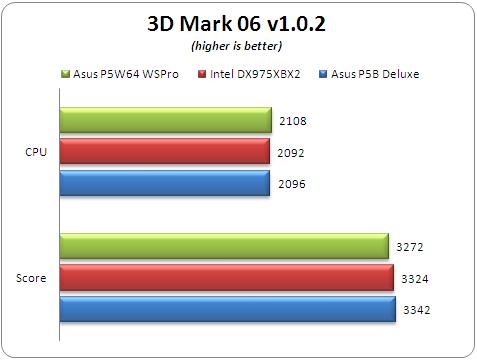
3D Mar06 tests both CPU and RAM as well as the VGA card. The Asus P5W64WS Pro registered the highest CPU performance but again, the lowest overall score.
7. Scienc Mark - Pov Ray
 Science Mark 2.0 is an attempt to put the truth behind benchmarking. In an attempt to model real world demands and performance, SM2 is a suite of high-performance benchmarks that realistically stress system performance without architectural bias. Science Mark 2.0 is comprised of 7 benchmarks, each of which measures a different aspect of real world system performance.
Science Mark 2.0 is an attempt to put the truth behind benchmarking. In an attempt to model real world demands and performance, SM2 is a suite of high-performance benchmarks that realistically stress system performance without architectural bias. Science Mark 2.0 is comprised of 7 benchmarks, each of which measures a different aspect of real world system performance.
Pov-Ray s a high-quality, totally free tool for creating stunning three-dimensional graphics. It is available in official versions for Windows, Mac OS/Mac OS X and i86 Linux. The source code is available for those wanting to do their own ports. We used Pov-Ray 3.7beta15 for all tests, since it supports Dual Core CPUs. We used the built-in benchmark as suggested by the developers.
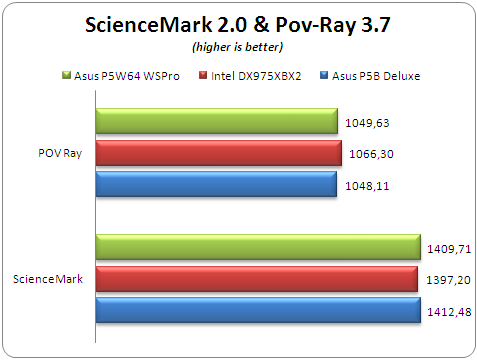
In ScienceMark, the Asus P5B Deluxe had the best performance due its higher memory settings, while in Pov-Ray, the Asus P5W64WS Pro was second to the Intel DX975XBX2.
- Nero Digital
Nero Digital is one of the best known Digital formats, offering both ASP and AVC encoder profiles.

_Profiles.png)
For our tests, we used the latest version of Nero Recode v2.3.1.8 as packaged with Nero Reloaded v7.5.0.1. As a source we used a VOB file of 5 mins duration. We encoded for each processor two modes (ASP, AVC) with exactly the same preferences (Same bitrate and Dual pass). The encoding time displayed below is what Nero Recode reported. The lower the time taken, the better. All results are displayed in seconds.
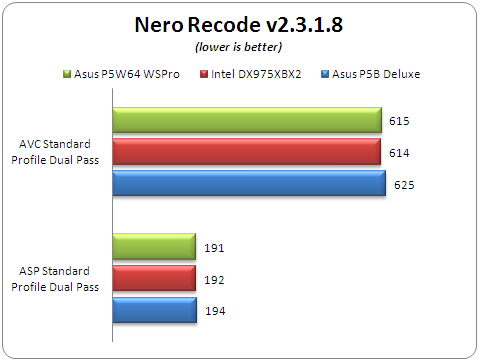
All three tested motherboards had similar performance with Nero Recode. The Asus P5W64WS Pro was a very good performer.
8. CineBench - SuperPi
 CINEBENCH is the free benchmarking tool for Windows and Mac OS based on the powerful 3D software CINEMA 4D. Consequently, the results of tests conducted using CINEBENCH 9.5 carry significant weight when analyzing a computer’s performance in everyday use.
CINEBENCH is the free benchmarking tool for Windows and Mac OS based on the powerful 3D software CINEMA 4D. Consequently, the results of tests conducted using CINEBENCH 9.5 carry significant weight when analyzing a computer’s performance in everyday use.
Especially a system’s CPU and the OpenGL capabilities of its graphics card are put through their paces (even multiprocessor systems with up to 16 dedicated CPUs or processor cores). During the testing procedure, all relevant data is ascertained with which the performance of different computers can subsequently be compared, regardless of operating system. All tests were done with the latest available build (R9.5), and the sum of each subtest is displayed at the following chart, except OpenGL Software & Hardware Lighting tests, since both depend on the installed VGA card.
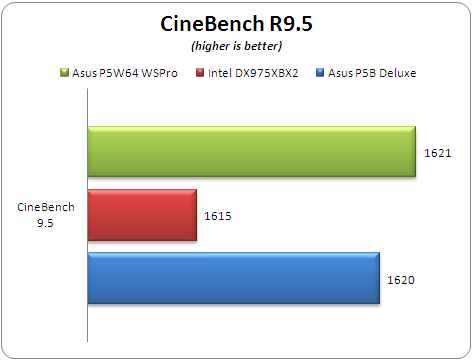
In CineBench, the Asus P5W64 WS Pro had the highest overall score.
 SuperPI has become a utility to benchmark modern systems. In August 1995, the calculation of pi up to 4,294,960,000 decimal digits was succeeded by using a supercomputer at the University of Tokyo. The program was written by D.Takahashi and he collaborated with Dr. Y.Kanada at the computer center, the University of Tokyo. This record-breaking program was ported to personal computer environment such as Windows NT and Windows 95 and called Super PI.
SuperPI has become a utility to benchmark modern systems. In August 1995, the calculation of pi up to 4,294,960,000 decimal digits was succeeded by using a supercomputer at the University of Tokyo. The program was written by D.Takahashi and he collaborated with Dr. Y.Kanada at the computer center, the University of Tokyo. This record-breaking program was ported to personal computer environment such as Windows NT and Windows 95 and called Super PI.
The software offers up to 32M calculations of PI numbers, for all CPUs we tested up to 8M calculations and sum them up for a total score.
Asus P5B Deluxe, due to its better memory handling, has the lowest sum of 8M+4M+2M+1M SuperPI results.
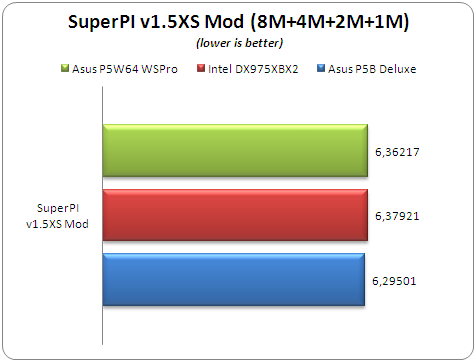
9. F.E.A.R. - Prey
- F.E.A.R
 The story begins as an unidentified paramilitary force infiltrates a multi-billion dollar aerospace compound. The government responds by sending in Special Forces, but loses contact as an eerie signal interrupts radio communications. When the interference subsides moments later, the team has been literally torn apart. As part of a classified strike team created to deal with threats no one else can handle, your mission is simple: Eliminate the intruders at any cost. Determine the origin of the signal. And contain this crisis before it spirals out of control.
The story begins as an unidentified paramilitary force infiltrates a multi-billion dollar aerospace compound. The government responds by sending in Special Forces, but loses contact as an eerie signal interrupts radio communications. When the interference subsides moments later, the team has been literally torn apart. As part of a classified strike team created to deal with threats no one else can handle, your mission is simple: Eliminate the intruders at any cost. Determine the origin of the signal. And contain this crisis before it spirals out of control.
The game offers up to 1280x960 resolution, which is used for all tests. We maxed all details for CPU and VGA card, except for AA/AF and Soft Shadows which are enabled as shown in each graph. Below are the results after using the built-in benchmark test:

The Asus P5W64WS Pro had slightly better performance than the P5B Deluxe.
- Prey
 Prey tells the story of Tommy, a Cherokee garage mechanic stuck on a reservation going nowhere. His life changes when an otherworldly crisis forces him to awaken spiritual powers from his long-forgotten birthright. Abducted along with his people to a menacing mothership orbiting Earth, he sets out to save himself and his girlfriend and eventually his planet.
Prey tells the story of Tommy, a Cherokee garage mechanic stuck on a reservation going nowhere. His life changes when an otherworldly crisis forces him to awaken spiritual powers from his long-forgotten birthright. Abducted along with his people to a menacing mothership orbiting Earth, he sets out to save himself and his girlfriend and eventually his planet.
Prey is serious, dark story, based on authentic Cherokee mythology. Themes of sacrifice, love and responsibility are explored and the story dives into emotional territory not yet explored by similar games. Prey is based on Quake 3 engine and for sure will keep you awake many nights...
For all tests, we used hocbench which offers all benchmarking options through a GUI. We used the built-in Guru3D timedemo and all results are posted below:

Prey is based on the Quake3 engine, making it CPU dependent. Again, the Asus P5W64WS Pro was fastest.
10. Splinter Cell Chaos Theory - Half Life 2
- Splinter Cell Chaos Theory
 A Japanese Information Defense Force is formed to help face modern threats. Deemed a violation of international law and of the Japanese Post-War Constitution, Korea and China become outraged. Secretly, the head of the IDF begins launching information-warfare attacks against Japan and blaming the attacks on North Korea. When the U.S. intervenes, as they are obligated to under Article 9 of the Japanese Post-War Constitution, the U.S. is attacked as well, forcing North Korea to escalate the situation with a pre-emptive invasion of South Korea.
A Japanese Information Defense Force is formed to help face modern threats. Deemed a violation of international law and of the Japanese Post-War Constitution, Korea and China become outraged. Secretly, the head of the IDF begins launching information-warfare attacks against Japan and blaming the attacks on North Korea. When the U.S. intervenes, as they are obligated to under Article 9 of the Japanese Post-War Constitution, the U.S. is attacked as well, forcing North Korea to escalate the situation with a pre-emptive invasion of South Korea.
As war erupts on the Korean Peninsula, Sam Fisher must thwart the alliance between the Japanese Admiral, a neurotic computer hacker, and the head of an international paramilitary company in order to prevent the rekindling of a massive world war in the Pacific.
The graphics engine supports Pixel Shader 3 and HDR along with other new effects. We used hocbench which offers all benchmarking options through a GUI. We used the built-in "Guru3D 2" timedemo and all results are posted below:
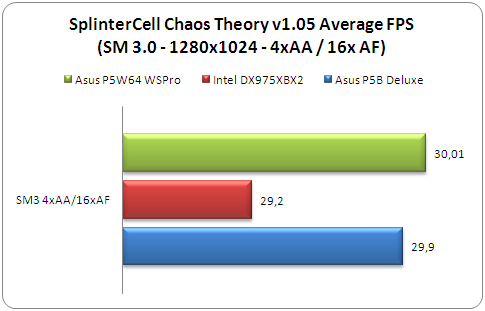
- Half Life 2 Episode 1
The world of Half-Life 2 has amazed everyone with its great story, graphics and Valve's great support. Half-Life 2: Episode One is the first in a series of new adventures created by Valve that extend the Half-Life 2 single player experience. It details the aftermath of Half Life 2 and launches a journey beyond City 17.
 Stepping into the hazard suit of Dr. Gordon Freeman, you face the immediate repercussions of your actions in City 17 and the Citadel. Rejoin Alyx Vance and her robot, Dog, to once again aid the human resistance in their desperate battle against the totalitarian alien menace of the Combine.
Stepping into the hazard suit of Dr. Gordon Freeman, you face the immediate repercussions of your actions in City 17 and the Citadel. Rejoin Alyx Vance and her robot, Dog, to once again aid the human resistance in their desperate battle against the totalitarian alien menace of the Combine.
Episode One exposes Alyx's combat skills and knowledge of City 17. Battle side-by-side with her through Valve's first episodic game, a four-to-six hour adventure of greater density and detail than non-episodic releases.
We recorded a timedemo and used the console to run each card with different visual quality settings. For all tests, we enabled 1280x1024 with HDR shadows fully enabled.
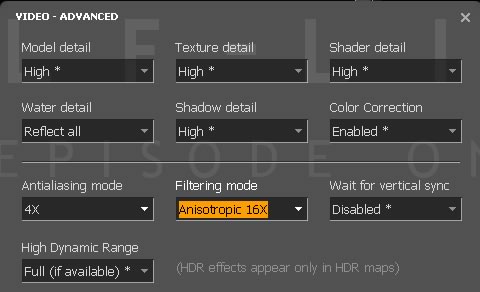
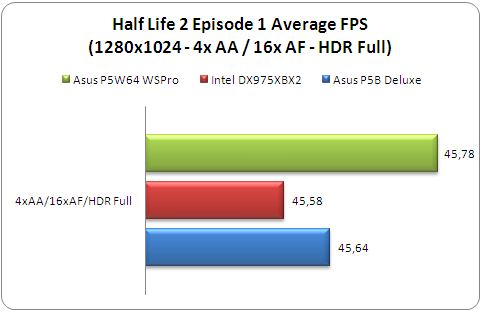
11. Overclocking
- Overclocking
The Asus P5W64WS Pro isn't advertised as an overclocking champion. Regardless, Asus provides all the necessary options for users to tweak their system and discover just how high they can go. As we saw in the BIOS page, the FSB on the Asus P5W64WS can go up to 550MHz. Our first experiment was to find out just how high we could push the FSB, without any voltage tweaks. We set Intel's E6600 internal CPU multiplier to 6x and got a stable system at 395MHz.


It's not as high as the P5B Deluxe which reached 430MHz with the exactly same components. Of course, overclocking depends on several factors such as CPU, cooling system and RAM.
We then tried to find the maximum FSB after setting the internal CPU multiplier to 9x and raising the FSB. We managed to get a stable system at 3.110GHz with FSB at 345MHz. While it's impressive, the P5B Deluxe was somewhat better managing 350MHz FSB.


Concluding our overclocking attempts, without any voltage tweaks we raised the FSB up to 400MHz. However, there are reports from our publications and forums indicating that the P5W64 WS Pro can go up to 470~500FSB (with the proper voltage tweaks and the selected CPU/RAM combination). The Asus P5B Deluxe can go at least that high, maybe even higher...
12. Working with 8 monitors
The Asus P5W64WS Pro has four (4) PCI-E slots. It is therefore possible to install up to four VGA PCI-Express bus cards. To be exact, you can install either two or four VGA cards, but not three. We were curious to test if the Asus P5W64WS Pro could properly handle four VGA cards, so we managed to get our hands on four identical Nvidia 7900GS cards. The reason we selected the specific card, is that it is a slim VGA card and would fit without a lot of hassle. You must be very careful when selecting the model of VGA card to use in a multiple card setup, since there isn't a lot of free space between the PCI-E slots.
We made a fresh installation of Windows XP SP2 with all the latest updates and Nvidia's Forceware 93.71 revision drivers. Installing four PCI-E cards is somewhat tricky. The best way to do it is by starting from the 4th slot (bottom in the photo below) working up to the first (top). Another problem is how to provide power to four PCI-E cards, since most PSUs only have two rail channels specifically for VGA cards. We solved this by using the Thermaltake Purepower Express 250W, which provides two additional power cables for VGA cards. Our system was installed in a Thermaltake Soprano case. It's important to arrange all cables neatly and to the side so that there is a free flow of air in and around the cards to dissipate generated heat:

The next big task was to gather together eight VGA monitors. Yes, that's right, you can have up to 8 monitors connected at the same time, since each VGA card has two outputs. We happened to have 8 monitors in our labs, from various manufacturers (EIZO, Samsung, Belinea) and using the DVI-D to VGA converters we connected them to the VGA cards:

The next step would be boot Windows and see what would happen. After sometime, playing around with the Forceware settings, we created a massive 7680x1024 (virtual) desktop. This was done by selecting 1024x960 resolution for all monitors. If for example, we had selected 1280x1024, we would get 10240x1024 resolution:

Working with so many screens is quite strange, since you have to move the cursor from one desktop to other and at the same time not lose your focus. As was expected, you cannot have separate virtual desktops on the same machine, meaning one screen playing video, an Excel spreadsheet on another, etc. This is how our virtual desktop would look like, if we could see it panoramically:

With Forceware, all four Nvidia 7900GS cards were identified without any problems, and each card had two monitors:




Unfortunately, Nvidia Forceware can only mix the two monitors available for each VGA card and not all 8. The modes available are Single:

Clone mode:

Horizontal/Vertical Span:

Or independently:

The Nvidia Classic Forceware GUI seems more practical for this scenario:

You may wonder if SLI could work with this board. The answer is yes, but with limitations. First of all, you have to install two identical VGA cards in the 1st and 3rd slots. In this mode, the first slot works at x16 while third at x4. With hacked drivers, SLI does work and without any problems. A more interesting scenario would be to install four identical cards and after pairing them, enable 2x SLI mode (!). That was our typical installation after all, and the bad news is that it didn't work. We tried to pair 1-3, 2-4 VGA cards, but no luck. We tried other combinations (1-2, 3-4, 1-4, 2-3,etc..) but again, it didn't work. We imagine that SLI needs at least one PCI-E working at x16, or simply the drivers (remember are 85.96 revision), couldn't handle 2x SLI working mode.
Another more extreme scenario would be to mix both SLI and Crossfire cards on this board. For this experiment, we used 2 Asus EAX1650XT Crossfire Edition cards we had in our labs. However, the cooling system on these cards is so large that we couldn't fit in all four cards. It was simply not possible to install both the Nvidia 7900GS and ATI 1650XT cards, due to the fans.
13. Conclusion
- Conclusion
 The Asus P5W64WS Pro fulfills the needs of office and professional users with support for four PCI-E slots, allowing for up to eight monitors to be connected. Engineers, architects and graphics artists will appreciate the ability to have so many VGA cards on board. The motherboard supports all currently sold Intel processors for the 775 socket, Intel® Core™ 2 Duo/ Intel® Pentium® D/Intel® Pentium® 4/ Intel® Celeron® D processors.
The Asus P5W64WS Pro fulfills the needs of office and professional users with support for four PCI-E slots, allowing for up to eight monitors to be connected. Engineers, architects and graphics artists will appreciate the ability to have so many VGA cards on board. The motherboard supports all currently sold Intel processors for the 775 socket, Intel® Core™ 2 Duo/ Intel® Pentium® D/Intel® Pentium® 4/ Intel® Celeron® D processors.
On top of the ususal set of tests, we also installed four VGA cards and connected eight monitors. The ability to create a virtual desktop of up to 10240x1024 (assuming you are using 19" TFT monitors) is very interesting, especially for architects and designers. The only problem is the limited space between PCI-E slots which limits the choice of VGA card to slim ones. Using two identical VGA cards can also enable SLI or Crossfire, assuming you are using the "proper" driver pack.
In all our tests, the P5W64WS Pro was found to be as fast or faster than the P5B Deluxe, especially in CPU tests. The Asus P5B Deluxe was faster in the memory tests, since the P5W64WS Pro could not set our Crucial PC2-8000 to run at 1:2 (FSB:RAM). We hope that this "problem" will be fixed with a newer BIOS revision.

The board itself is of good overall design, as we have come to expect from ASUS. There is plenty of free space around the CPU area, allowing for the installation of large 3rd party fans. The memory banks are color coded for dual channel memory setups. There's an extra power input in case you install more than one VGA card. Apart from the IDE and floppy connections, it also has seven SATA II connections for HDD and optical storage devices. There are several other expansion slots available on board and Asus has included all the required cables in the retail package.
The board proved to be easy to overclock and somewhat similar to the Asus P5B Deluxe. We managed to reach a top FSB of 395Mz without any voltage tweaks. The Asus P5B Deluxe had reached 430MHz in the same test. There are many options in BIOS to "play" with. Other reviewers have reported reaching as high as ~500MHz, with of course, a different cooling system, CPU and memory modules.
Ending our presentation, we would say that this board is not for everyone, especially with a retail price of US$295~320. With four PCI-E slots and the capabilities that this feature offers, it is aimed at a specific target group.
It proved to be very stable during our testing, it has unique features, its performance was very good and overall, we feel it is a great product. Combined with a good Core2Duo processor and plenty of memory, it can be a very powerful system. If you can afford the price tag, this is a motherboard you definitely want to have for your Core2Duo processor.